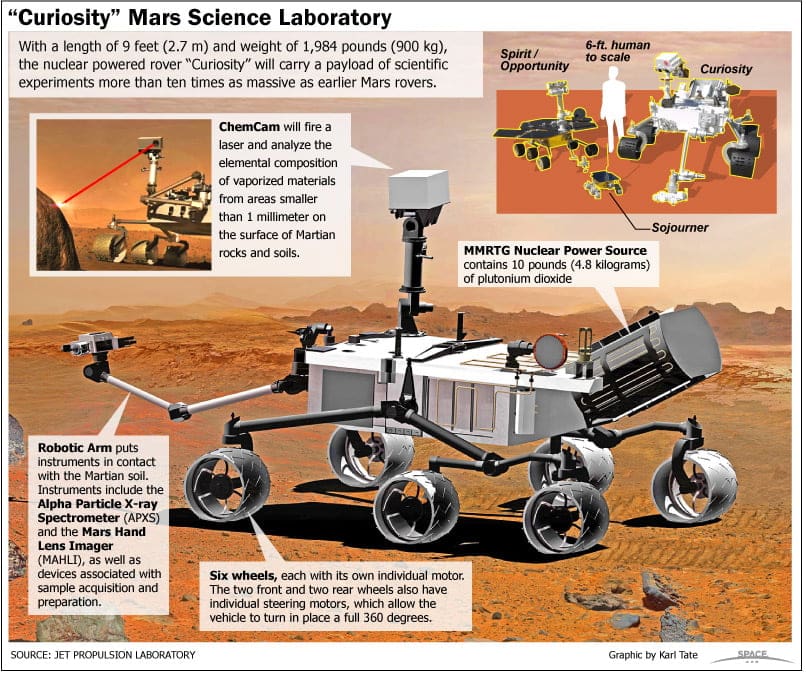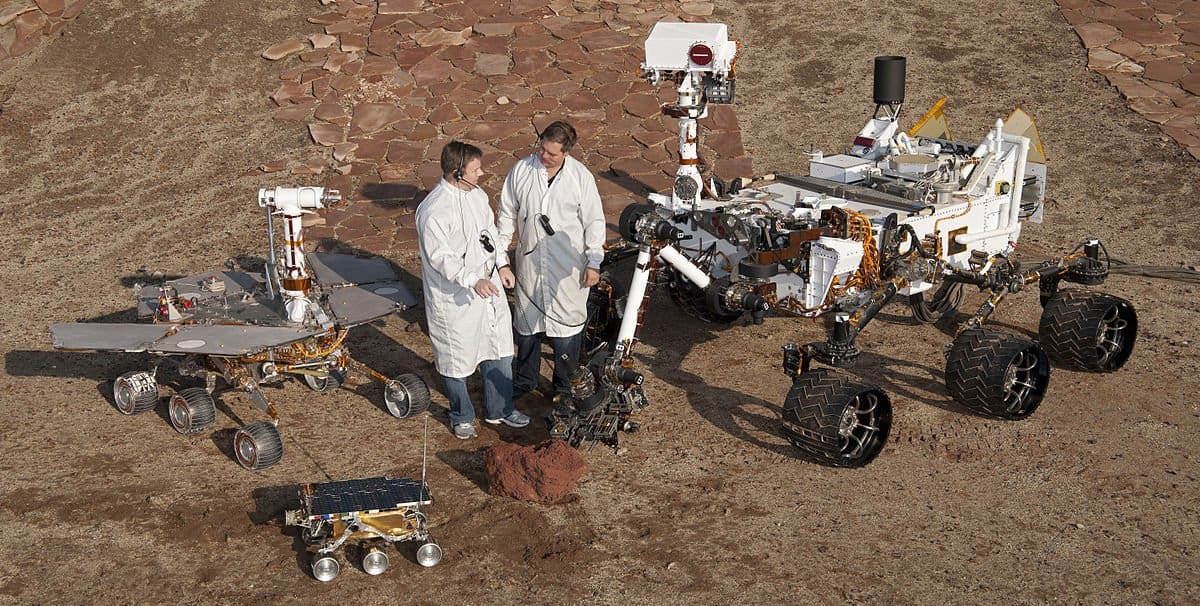Mars Curiosity: Facts and Information: The Mars Science Laboratory and its rover centerpiece, Curiosity, is the most ambitious Mars mission yet flown by NASA. The rover’s primary mission is to find out if Mars is, or was, suitable for life. Another objective is to learn more about the red planet’s environment.
Curiosity’s size allows it to carry a host of scientific experiments to zap, analyze and take pictures of any rock within reach of its 7-foot (2 meters) arm. Curiosity is about the size of a small SUV. It is 9 feet 10 inches long by 9 feet 1 inch wide (3 m by 2.8 m) and about 7 feet high (2.1 m). It weighs 2,000 lbs. (900 kilograms). Curiosity’s wheels have a 20-inch (50.8 cm) diameter.
Engineers at NASA’s Jet Propulsion Laboratory designed the rover to roll over obstacles up to 25 inches (65 centimeters) high and to travel about 660 feet (200 meters) per day. The rover’s power comes from a multi-mission radioisotope thermoelectric generator, which produces electricity from the heat of plutonium-238’s radioactive decay.
A complicated landing
The $2.5-billion MSL spacecraft launched from Cape Canaveral, Florida, on Nov. 26, 2011, and arrived on Mars on Aug. 6, 2012, after a daring landing sequence that NASA dubbed “Seven Minutes of Terror.” Because of Curiosity’s weight, NASA determined that the past method of using a rolling method with land bags would probably not work. Instead, the rover went through an extremely complicated sequence of maneuvers to land.
From a fiery entry into the atmosphere, a supersonic parachute needed to deploy to slow the spacecraft down. NASA officials said the parachute would need to withstand 65,000 lbs. (29,480 kg) to break the spacecraft’s fall to the surface.
Under the parachute, MSL let go of the bottom of its heat shield so that it could get a radar fix on the surface and figure out its altitude. The parachute could only slow MSL to 200 mph (322 kph), far too fast for landing. To solve the problem, engineers designed the assembly to cut off the parachute, and use rockets for the final part of the landing sequence.
About 60 feet (18 m) above the surface, MSL’s “skycrane” deployed. The landing assembly dangled the rover below the rockets using a 20-foot (6 m) tether. Falling at 1.5 mph (2.4 kph), MSL gently touched the ground about the same moment the skycrane severed the link and flew away, crashing into the surface.
NASA personnel tensely watched the rover’s descent on live television. When they received confirmation that Curiosity was safe, engineers pumped fists and jumped up and down in jubilation.
News of the landing spread through social media, such as Twitter and Facebook, and traditional outlets such as newspapers and television. One engineer became famous because of the Mohawk he sported on landing day.
Tools for finding clues to life
The rover has a few tools to search for habitability. Among them is an experiment that bombards the surface with neutrons, which would slow down if they encounter hydrogen atoms: one of the elements of water.
Curiosity’s 7-foot arm can pick up samples from the surface and cook them inside the rover, sniffing the gases that come out of there and analyzing them for clues as to how the rocks and soil formed.
The Sample Analysis of Mars instrument, if it does pick up evidence of organic material, can double-check that. On Curiosity’s front, under foil covers, are several ceramic blocks infused with artificial organic compounds. [Related: Curiosity Rover Finds Methane on Mars]
Curiosity can drill into each of these blocks and place a sample into its oven to measure its composition. Researchers will then see if organics appear that were not supposed to be in the block. If so, scientists will likely determine these are organisms hitchhiking from Earth.
High-resolution cameras surrounding the rover take pictures as it moves, providing visual information that can be compared to environments on Earth. This was used when Curiosity found evidence of a streambed, for example.
Primary mission: Can, or could, Mars support life?
Curiosity’s prime mission is to determine if Mars is, or was, suitable for life. While it is not designed to find life itself, the rover carries a number of instruments on board that can bring back information about the surrounding environment.
Scientists hit something close to the jackpot in early 2013, when the rover beamed back information showing that Mars had habitable conditions in the past.
Powder from the first drill samples that Curiosity obtained included the elements of sulfur, nitrogen, hydrogen, oxygen, phosphorus and carbon, which are all considered “building blocks” or fundamental elements that could support life. While this is not evidence of life itself, the find was still exciting to the scientists involved in the mission.
“A fundamental question for this mission is whether Mars could have supported a habitable environment,” stated Michael Meyer, lead scientist for NASA’s Mars Exploration Program. “From what we know now, the answer is yes.”
Scientists also detected a huge spike in methane levels on Mars in late 2013 and early 2014, at a level of about 7 parts per billion (compared to the usual 0.3 ppb to 0.8 ppb). This was a notable finding because in some circumstances, methane is an indicator of microbial life. But it can also point to geological processes. In 2016, however, the team determined the methane spike was not a seasonal event. There are smaller background changes in methane, however, that could be linked to the seasons.
Curiosity also made the first definitive identification of organics on Mars, as announced in December 2014. Organics are considered life’s building blocks, but do not necessarily point to the existence of life as they can also be created through chemical reactions.
“While the team can’t conclude that there was life at Gale crater, the discovery shows that the ancient environment offered a supply of reduced organic molecules for use as building blocks for life and an energy source for life,” NASA stated at the time.
Initial results released at the Lunar and Planetary Science conference in 2015 showed scientists found complex organic molecules in Martian samples stored inside the Curiosity rover, but using an unexpected method.
Vapors from a “wet chemistry” experiment filled with a fluid called MTBSTFA (N-methyl-N-tert-butyldimethylsilyl-trifluoroacetamide) contaminated a gas-sniffing analysis instrument shortly after Curiosity landed.
Since the scientists knew the collected samples were already reacting with the vapor, they eventually derived a way to seek and preserve the organics after extracting, collecting and analyzing the vapor. Analyzing the exact composition of the organics will take more time.
Second mission objective: Check out the environment
Besides hunting for habitability, Curiosity has other instruments on board that are designed to learn more about the environment surrounding it. Among those goals is to have a continuous record of weather and radiation observations to determine how suitable the site would be for an eventual human mission.
Curiosity’s Radiation Assessment Detector runs for 15 minutes every hour to measure a swath of radiation on the ground and in the atmosphere. Scientists in particular are interested in measuring “secondary rays” or radiation that can generate lower-energy particles after it hits the gas molecules in the atmosphere. Gamma rays or neutrons generated by this process can cause a risk to humans. Additionally, an ultraviolet sensor stuck on Curiosity’s deck tracks radiation continuously.
In December 2013, NASA determined the radiation levels measured by Curiosity were manageable for a crewed Mars mission in the future. A mission with 180 days flying to Mars, 500 days on the surface and 180 days heading back to Earth would create a dose of 1.01 sieverts, Curiosity’s Radiation Assessment Detector determined. The total lifetime limit for European Space Agency astronauts is 1 sievert, which is associated with a 5-percent increase in fatal cancer risk over a person’s lifetime.
The Rover Environmental Monitoring Station measures the wind’s speed and chart its direction, as well as determining temperature and humidity in the surrounding air. By 2016, scientists were able to see long-term trends in atmospheric pressure and air humidity. Some of these changes occur when the winter carbon-dioxide polar caps melt in the spring, dumping huge amounts of moisture into the air.

Mars Curiosity: Facts and Information – Hiduth.com
Technical snags and milestones
Curiosity ran into its first major problem in February 2013, when a computer glitch punted the roving laboratory into safe mode for a few days. The issue caused an interruption of normal science activities, but did not impact the rover’s long-term health.
But a more long-term problem has been the state of the rover’s wheels. While some damage was expected, by 2014 controllers were making accommodations in the rover’s routing to slow down the appearance of dings and holes.
“They are taking damage. That’s the surprise we got back at the end of last year,” said Jim Erickson, Curiosity project manager at NASA’s Jet Propulsion Laboratory (JPL) in Pasadena, California in a July 2014 interview. “We always expected we would get some holes in the wheels as we drove. It’s just the magnitude of what we’re seeing that was the surprise.”
In September 2014, Curiosity arrived at its science destination, Mount Sharp (Aeolis Mons) shortly after a NASA science review said the rover should do less driving and more searching for habitable destinations. It is now carefully evaluating the layers on the slope as it moves uphill. The goal is to see how the climate of Mars changed from a wet past to the drier, acidic conditions of today.
“I think the principal recommendation of the panel is that we drive less and drill more,” Curiosity project scientist John Grotzinger said during a news conference at the time. “The recommendations of the review and what we want to do as a science team are going to align because we have now arrived at Mount Sharp.”
NASA pioneered a new drilling technique at Mount Sharp in February 2015 to begin operations at a lower setting, a requirement for working with the soft rock in some of the region. (Previously, a rock sample shattered after being probed with the drill.)

